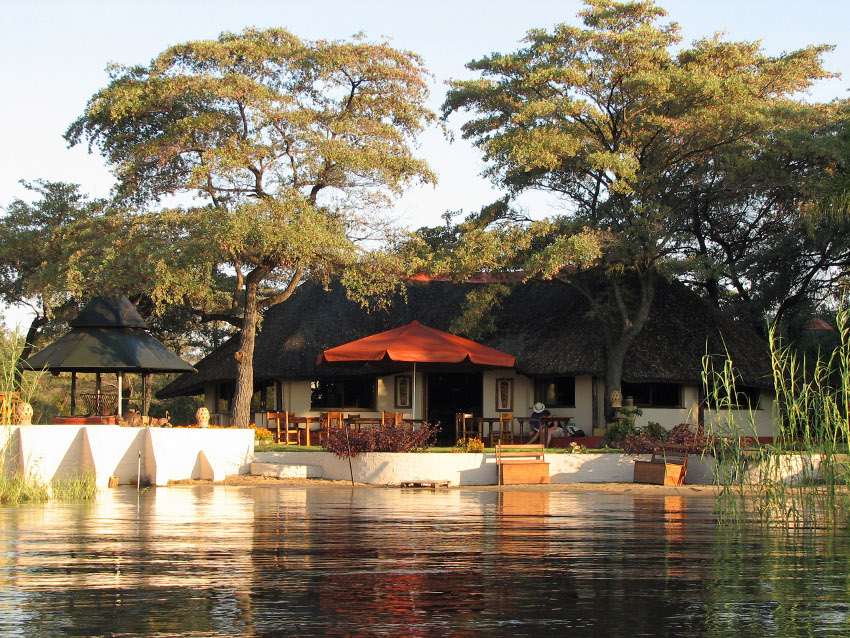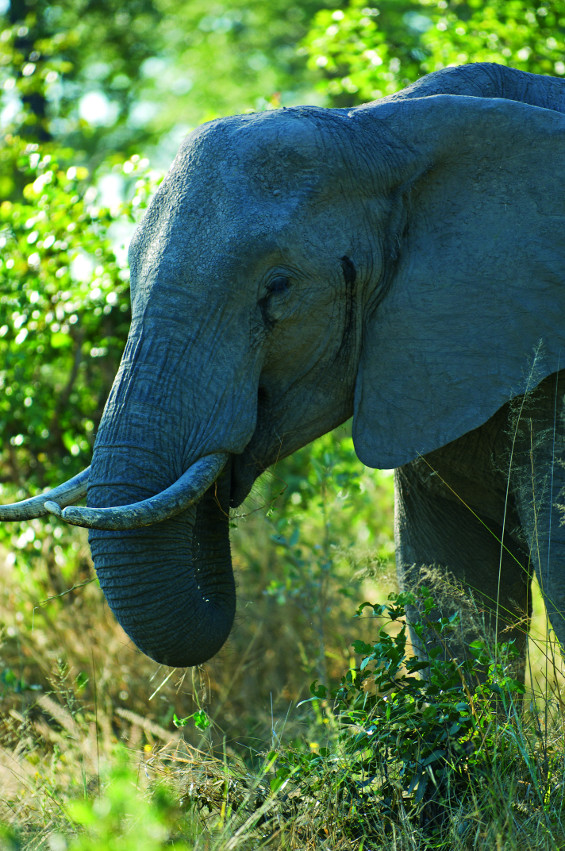Top 10 Adrenaline pumpers in Namibia
April 18, 2013Joy over cheetah cubs
April 19, 2013The perfect balance for desert beauty
Throw a handful of stars, wizened elephant giants, a multi-coloured chorus of birds and a magical water-world together and you have the ingredients for a holiday to remember. Add attractive campsites, from which to savour the mix of ingredients, mix gently and let it set in the fascinating world of Caprivi. It’s bound to be good.
The Caprivi provides the perfect balance when exploring Namibia, complementing the stark, scenic desert beauty experienced elsewhere in the county. Here, woodland, wildlife, floodplains, communities and rivers reign supreme. Welcome to the Caprivi!
The Trans-Caprivi Highway (or B8) in north-eastern Namibia points towards the heart of Africa. Essentially it begins at Rundu in the Kavango Region and continues eastwards along the narrow stretch above Botswana to Katima Mulilo and then southwards to Ngoma. Elephant caution signs interspersed with signs advising you to reduce your speed dot the sides of this corridor amidst trees and villages, and an almost palpable feeling of being in Africa envelops you.
Campers are inordinately privileged in this area to camp in unfenced community campsites in the national parks and on riverbanks. This is back-to-nature quality time, returning to the magnificence of the wilderness and the simple pleasures of life. The community campsites are constructed attractively with natural material from the surroundings, have flush toilets and ‘donkey’ wood burners or solar panels to generate hot water – ultimate luxury while camping in the bush. Mother Nature provides the rest. The campsites are the perfect bases from which to explore the national parks or just to pause and luxuriate in the natural world.
Campsites for every preference
Those who prefer more creature comforts need not lose heart. Along the river courses there are ample campsites at established lodges that afford you the opportunity to experience the rich water-world and spice your journey with a bit of variety. They offer the appealing options of enjoying meals at their restaurants, sipping sundowner drinks on a lodge deck or taking a boat ride along the river. A few good stopping points along the way include the green-grassed and peaceful Hakusembe River Lodge near Rundu, Ngepi near Divundu – renowned for its whacky toilets – and the friendly bird-haven, Namushasha, further to the east on the Kwando River.
For those who prefer the back-to-nature experience, there is a selection of community campsites to visit. Among these, and to begin your bush camp-river vacation in a peaceful spot, Mbamba is a riverside hideaway approximately 40 km from Rundu. Its four sites are positioned under trees, each having its own bathroom and lapa area. To reach this riverside retreat, turn left at the Shambyu turnoff if travelling eastwards, and then right onto the D3402 towards Mashare.
The next campsite to watch out for along the Trans-Caprivi Highway is N//goabaca, situated next to Popa Falls, a series of small rapids on the Okavango River. The turn-off is located just after the Okavango River bridge near Divundu. Sites are positioned with views of the rapids, two with riverside decks. Each has its own bathroom facilities and thatched open-kitchen area. A short drive along the campsite road leads you to the prime viewing spot of the Popa Falls, a tranquil enclosure surrounded by Phragmites reeds and sandy banks. The name of the campsite stems from the Khwe words for ‘boiling water’, and the soothing sound lulls you into campers’ heaven. As you sit on your deck watching the sun sink or around your fire under a starlit sky, you will surely praise the simple and supreme joys of camping.
Run by the local communities
The two well-known and popular community campsites further east in the Bwabwata National Park are Bumhill and Nambwa, located on opposite sides of the road before Kongola, and both excellent bases for exploring Bwabwata. Bumhill is positioned just off the main road and is easily accessible for all vehicles. It has three bush-camp sites with shared bathroom facilities and three private sites with their own bathrooms and decks overlooking the Kwando River. With no fences surrounding the campsite, elephants may wander through, while the sounds of the wild serenade you, reminding you of the rare privilege of being able to camp inside a national park.
For those with 4×4 vehicles, the road to Nambwa is a long, sandy track. Set alongside the river under large shady trees, the bush camp is an idyllic spot for nature lovers. Five sites are positioned on the riverbank, with one slightly further back. From Nambwa, the Bwabwata area around the campsite can be explored. Various viewpoints along the river provide good viewing places, amongst which Horseshoe, a horseshoe-shaped bend in the river, is a popular spot for elephants. Visitors to the two Bwabwata campsites are required to register and pay park fees at the Susuwe ranger station further down the Bumhill road. (This is a sandy road most effectively traversed by a 4×4 vehicle.)
The road continues into Bwabwata National Park for further exploration.
Fifty kilometres south-east of Katima Mulilo, near Ngoma and the Botswana border, the remote Salambala Campsite provides a touch of wilderness in mopane woodland dotted with termite mounds. Be sure to visit Ngoma Craft Centre for its variety of local handicraft including its baskets, mats, wood carvings and clay pots.
Reverberating sounds of bird calls, the chiming of frogs, the rare sight of lechwe in the distance, the bark of a kudu in the night, the grunt of a hippo in the waterways, and the grace of water lilies are some of the cherished pleasures of camping in the Caprivi.
TRAVEL TIPS
- If staying at the community campsites, come prepared by bringing your own drinking water, as it is often pumped directly from the rivers.
- Don’t swim in the rivers; the Caprivi is crocodile and hippo territory.
- It is advisable to have a hot shower in the evening if the campsite makes use of solar power, as the water will have cooled by morning.
- For all Trans-Caprivi campsites, it is recommended to check the condition of the roads during the rainy season before your arrival.
- 4x4s are required for the Caprivi national parks – Bwabwata, Mamili and Mudumu.
CORRIDOR OF DREAMS
The Caprivi corridor was named after German Chancellor, Count George Leo von Caprivi. In 1890 he negotiated with the United Kingdom that the northern strip of Bechuanaland (the present-day Botswana) be annexed to German South-West Africa as part of the Heligoland-Zanzibar Treaty. The Germans hoped this would give them access into the African interior via the Zambezi River. They didn’t take into account, however, that the Zambezi plummets down Victoria Falls along its journey.
CHILLI BOMBS
The chilli-bomb project in the Caprivi Region of Namibia was initiated by the Integrated Rural Development and Nature Conservation (IRDNC) in 2004 to thwart the attempts of elephants to dine on the crops cultivated by community members.
Dried chillies are ground to a powder and mixed with dung to make an ‘elephant chilli bomb’ or ‘elephant coil’. When lit, the strong chilli smoke deters the elephants, driving them off effectively and precluding any need for aggression.
LATERAL THINKING
The area is a good example of how people and wildlife can live harmoniously side by side, and of the success of the conservancy programme in Namibia. Communities in registered conservancies take responsibility for and simultaneously benefit from the wildlife – and tourism – in their areas. Wildlife has been reintroduced into conservancies, re-stocking once-abundant areas. Through the game-guard system, poaching is monitored and wildlife has increased.
THE LIVING MUSEUM OF THE MAFWE
The creative concept of the living museum was developed by the Living Culture Foundation of Namibia. The Living Museum of the Mafwe provides the opportunity for visitors to experience the traditional life of the Mafwe, while reinforcing their traditional culture. Visitors can experience the hip-waggling dances, buy locally produced crafts, and learn about traditional fishing methods and local weaving techniques. Slow down and meet the local Caprivians for an unparalleled experience.
The Living Museum is located before Kongola, 19 km down the D3502.
www.lcfn.info
BASKETS AND BEADS
Mashi Crafts is an art-and-crafts outlet not to be missed on the Trans-Caprivi route. It stocks the well-crafted items, including high-quality baskets, wood-carvings and reed mats made by the surrounding communities. The Caprivians are talented craftspeople known for their time-consuming crafts. Mashi Crafts provides a much-needed outlet for these Caprivian works of art. Situated at the B8/D3502 intersection in Kongola, this is the place for buying Namibian gifts to take home with you.
SYNERGY
The Bwabwata National Park extends across the Caprivi corridor from the Okavango River in the west to the Kwando River in the east. It is home to myriad wetland and woodland bird species and an abundance of wildlife, including roan, sable, elephant and buffalo. What is unusual and innovative about Bwabwata, is that there are communities living within its boundaries. When Namibia gained independence in 1990 there were thousands of people living in the Caprivi Game Park, as Bwabwata was then called. An ingenious solution was found – the area was zoned into conservation areas and a multiple-use area for the residents.
Text and photographs Ron Swilling
This article originally appeared in the Travel News Namibia 2013 Autumn edition.













